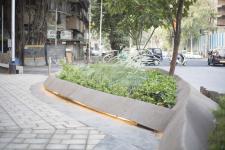The Urban Intervention was implemented to revamp the junction of Gokhale Road from where the maximum vehicles travel towards Worli. This is a widely used junction and through the footpath here is around 5 Metre wide it is usually used either by the hawker or used to park two-wheelers thereby reducing the usable space considerably.
Studio EMERGENCE studied the demographics and the housing typology around the pavement. The area largely comprises of Residential Buildings, Schools and Community spaces like parks and temples. It is also a space for an evening gathering of the elderlies. The design strategy was to incorporate all these parameters and use this data to govern the basic massing of the intervention.
“The first conscious decision we made was to retain a 3.5 to 4-meter wide pathway at every point and use the rest of the space as a buffer between the oncoming heavy traffic & pollution and for the people using these streets for the commute on a daily basis”. Said Seeja Sudhakaran & Khushbu Davda, Principle Architects at Studio EMERGENCE.
2017
2017
The intervention primarily was divided into two areas, softscapes and hardscapes. The built structure for the plantation was restricted to the edges so as to ensure smooth usage of the pavement even during rush hours and to create an illusion of flowing forms, the flooring itself was divided into different segments with the use of different materials. The organic shape of the structure was achieved by making an intricate framework of MS pipes which were later clad with Mild steel sheets and welded in place.
• 180 no. of sectional profiles were used in total which was all placed two feet apart to achieve the form. This process was much faster compared to using brickwork and cement.
The form changes drastically as one walks along the L shape pavement. It acts as a divider between the pavement and the plants at one point and seamlessly transforms itself into a seat in another. It also houses some service points wherein the existing Municipality drains are located. The seating space also has storage for local newspaper vendors. This multifunctional intervention was designed using sectional anthropomorphic data and the form was an outcome of all the requirements.
“Since the footpath is located at a major traffic junction we had to accommodate a lot of service and electrical points for MCGM. All the points were maintained and we also replaced the manholes with new FRP ones for longer and sturdy use and reliability”. Says Khusbhu Davda & Seeja Sudhakaran. “The massing design was complete as per the location and placement of these services. The parts where we could cover some of these units were designed specifically in such a way that it can be easily accessed and serviced. For example, a drain system that needed to be integrated into the design such that a part of the unit is attached on hinges which can open up for servicing, which helped us maintain the exact design and also maintain serviceability for the local authorities”.
All trees around the site are maintained and given new gratings of COR-TEN Steel to complement the surroundings. In terms of environmental objectives, the aim is to alleviate and reduce air and noise pollution, as there would be a reduction in the number of vehicles parking on the street side. Adding to the city’s green and clean campaign.
Khusbhu Davda, Seeja Sudhakaran, Priyanka Itadikar, Laukik Lad





